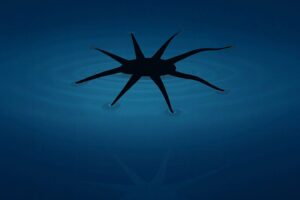HydroSpread: soft robots that can walk on water

The walking mechanism of the ‘water spider’ robot HydroBuckler prototype shown here is driven by ‘leg’ buckling (Credit: Baoxing Xu, UVA School of Engineering and Applied Science)
September 24, 2025 – Imagine a tiny robot gliding across a pond like a water strider. Researchers at the University of Virginia have taken a step toward making this real with HydroSpread, a method that forms soft, floating structures directly on water.
Traditional soft robotics relies on thin films made on rigid surfaces such as glass, which must then be carefully peeled away. That process often damages the delicate layers. HydroSpread solves the problem by letting water act as the work surface. Drops of liquid polymer spread naturally into ultrathin, even films, which can be cut into precise shapes with a laser.
Using this technique, the team built two prototypes. HydroFlexor paddles forward with fin-like strokes, while HydroBuckler ‘walks’ with nodding legs inspired by water striders. Both move when their films bend under heat from infrared light. By switching the heat source on and off, the researchers could control speed and direction.
The strength of HydroSpread lies in its balance of simplicity and accuracy. Because the films form directly on liquid, they remain smooth, thin, and reliable. The potential goes beyond robotics: the method could also support wearable medical sensors, flexible electronics, and environmental monitoring devices.
The study was published on September 24 in Science Advances under the title Processing soft thin films on liquid surface for seamless creation of on-liquid walkable devices.









